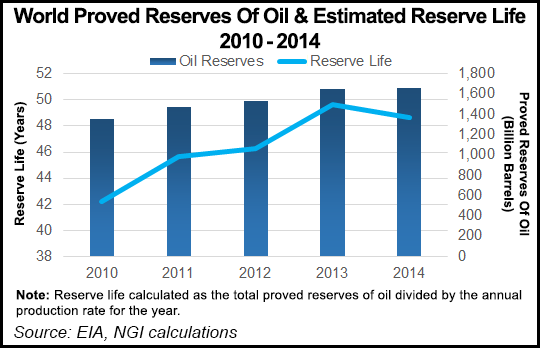Global Reserves Shortfall Forecast If Producers Eschew Exploration Investments
The global oil market faces a supply shortfall of 4.5 million b/d by 2035 if exploration success — and investments — aren’t stepped up, Wood Mackenzie researchers are forecasting.

Oil and gas discoveries in recent years have disappointed, with the volume of liquids unearthed from 2008 to 2015 falling by more than half, according to a study issued Wednesday. Significant discoveries made during the 2000s secured medium-term supply, but the sharp cutback in capital spending by the exploration and production sector is an ominous sign for building future reserves over the longer term, the Verisk Analytics business said.
Using its proprietary database, Wood Mackenzie studied the impact of exploration rates on global oil supply and reviewed all conventional fields discovered since 2000, said the firm’s Patrick Gibson, who directs global oil supply research.
“Over 7,000 conventional fields have been discovered in the last 15 years, and although these developments will play a critical role in securing future oil supply in the medium-term, modeling a continuation of poor exploration results shows that the market could see a 4.5 million b/d shortfall by 2035,” Gibson said.
The past four years of “largely gas-prone” exploration have been “disappointing” overall for the energy industry, said Vice President Andrew Latham, director of exploration research. The volume of liquids discovered every year between 2008 and 2011, about 19 billion bbl, slumped between 2012 to 2015 to only 8 billion bbl a year. Last year was the worst.
“The price downturn has resulted in large reductions in exploration spend and activity levels have been significantly impacted — just 2.9 billion bbl of liquids were discovered globally in 2015,” Latham said. “We currently expect the industry to invest $40 billion per year in exploration and appraisal over 2016 to 2018, less than half its investment during 2012 to 2014.”
Several “sizable discoveries” were made early in the 2000, when spending and exploration activity was at its peak. And more reserves are yet to be recovered, provided there’s enough investment.
“Substantial volumes of oil from these finds are still to be produced, around 90% of the liquids discovered, which should ensure supply growth in the medium term,” he said. “Conventional exploration success during the 2000s could add 18 million b/d by 2025, in addition to increasing tight oil recovery. However, the shift in the industry’s focus toward exploring smaller near-field opportunities with lower cost bases and shorter lead times now means that fewer large, high-risk frontier finds are likely to be made in the near term.”
Researchers estimated that more than 10% of global liquids supply by 2035 will be sourced from conventional volumes yet to be discovered, with North America, Africa and Latin America together accounting for around 60%.
“Existing discoveries do, of course, have a key role to play in future global oil supply, but unless exploration results start to improve significantly, continued supply growth will become unsustainable,” Gibson said. “We forecast that by 2030, production from fields discovered since 2000 will be in decline,” resulting in the projected shortfall by 2035. “This is why the size and nature of the next tranche of discoveries is crucial for maintaining long-term global oil supply growth.”
Producers are aware of the precarious situation and what could happen if investments continue to be stalled.
BP plc CFO Brian Gilvary said Tuesday operators would pay a price if projects were delayed much longer (see Daily GPI, April 26). “Inevitably, there are tradeoffs,” he said.
Last week Schlumberger Ltd. CEO Paal Kibsgaard said exploration and production (E&P) investments were not matching growing energy demand, which is a real concern down the line (see Daily GPI, April 22).
“I think we will need significant increases in E&P investment,” Kibsgaard said. “There’s no way you can get around that…If you look at new investments that are relatively short-cycle, there are two sources of that. It is going to be the conventional land international, and it’s going to be the unconventional land in North America.
“Both of these resource types are relatively short-cycle businesses, and production coming out of them is just going to be a function of the investment appetite. So I think the sources of additional production for 2017 are limited to these items…And beyond that, Ithink we need a widespread significant increase in E&P investments to get supply back to where it can meet growing demand.”
© 2024 Natural Gas Intelligence. All rights reserved.
ISSN © 1532-1231 | ISSN © 2577-9877 |
